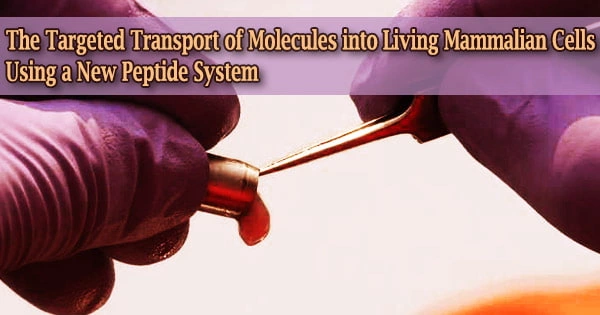The University of Bayreuth and the University of Bristol have created a novel peptide that is ideally suited for the targeted delivery of compounds, such as active ingredients and colors, into mammalian cells.
The peptide has a dual function that allows it to interact with another peptide inside the cell as well as outside the cell. Prior to the transported molecules’ intended action, the partner peptide must be introduced into the cell. The transport system described in the journal Nature Chemical Biology is a prime example of the exciting potential of peptide and protein de novo design.
Numerous active compounds that can start, speed up, or stop processes in mammalian cells have been created recently by the fields of biomedicine and pharmacology.
But in many instances, getting these compounds precisely where they are needed is still difficult. When coloring specific cellular structures for research or diagnostic purposes, the scenario is comparable.
It is accurate to say that endocytosis allows mammalian cells to take up foreign materials. However, this does not imply that you will be transported to the intended location.
The rational design of peptides is a novel study direction that Bayreuth scientist Prof. Dr. Birte Höcker is exploring with her research team. These should be capable of entering the interior of the cell from the outside and transporting any connected active ingredients or color molecules. Because they typically include fewer than 30 amino acids, peptides suited for this use tend to be relatively tiny.
But up until now, the issue has been that these peptides do not provide many potential applications, exactly because of their simplicity and tiny size. This is due to the limited locations in the various inner cell structures where they can dock and deliver the molecules they convey.
The Bayreuth and Bristol-developed peptide has eliminated this drawback. It is a basic peptide containing two elements that are crucial for its functionality a high concentration of arginine amino acids.
The new peptide system makes it clear that de novo design is a promising research approach in the search for methods that enable drug or dye molecules to be introduced into mammalian cells in a targeted and gentle manner.
Dr. Guto Rhys
One permits peptide entry into the interior of the cell, while the other permits interaction with an acidic companion peptide. This companion peptide can be positioned inside the cell in a variety of sites by applying recognized biochemical techniques.
Proteins, bigger molecular complexes, or organelles can be specifically targeted by the basic peptide that has entered the cell once they have been marked with the partner peptide. The basic peptide attaches to the acidic peptide like a key does to a lock.
The acidic companion peptide is specifically positioned by linking it with molecules that are then transfected into the DNA of the cell. The two previously unidentified de novo peptides were created by the Anglo-German research team utilizing computer-assisted protein design techniques.
The coiled-structured peptides that served as the foundation for this research were listed in a structural database. The computer-designed peptides were subsequently synthesized in the lab.
Here, X-ray crystallography and biophysical techniques were employed to determine the true characteristics and behavior of the peptides. The novel peptide system has even been found to be effective at transporting other peptides and proteins, according to tests done on eukaryotic cells and E. coli bacteria.
“Our investigations exemplify how the computational design of peptides and proteins, their subsequent synthesis and characterization in the laboratory, as well as testing in living cells can intertwine when innovative solutions for biochemical or biomedical questions are being sought,” says Prof. Dr. Birte Höcker, head of the Protein Design Group at the University of Bayreuth and corresponding author of the new study.
“The new peptide system makes it clear that de novo design is a promising research approach in the search for methods that enable drug or dye molecules to be introduced into mammalian cells in a targeted and gentle manner,” adds Dr. Guto Rhys, postdoc at the Protein Design research group and one of the three first authors.
















